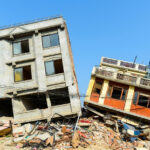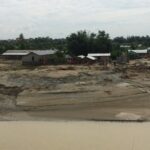Nepal is said to have one of the highest hydropower potentials in the world; with a capacity of 83,000 MW of which 42,000 MW is said to be economically feasible. However, apart from the various hydropower projects being developed at present, the country’s total installed hydroelectricity capacity stands at a far from encouraging figure of around 700 MW. In a country that boasts enormous hydropower potential, hydroelectricity accounts for a mere 2% of the total energy consumed. This clearly suggests that there is a big gap between electricity that could be supplied, and what is actually being supplied. Additionally, Energy demands are currently met primarily through traditional sources; such as firewood or petroleum products. Energy substitution with electricity could therefore result in a substantial increase in demand. There is however no studies to identify this latent demand for electricity, which must be taken into consideration to adequately identify future demand and supply.
Demand-Supply Mismatch: The economic embargo in Nepal has been affecting the already increasing demand for power as families have started substituting cooking gas fueled stoves with other electric appliances. With power cuts throughout the year span for as long as 10 hours or more everyday (during dry seasons), the demand for electricity exceeds supply. In FY 2012-13 Nepal Electricity Authority (NEA) was able to supply only 719 MW out of 1094 MW demanded. According to NEA projections, the electricity demand in the peak hour (evening) has reached 1350-1500 MW, while the demand in the morning stands at 1,080 MW and in the day time at 810 MW. Compared to this, the supply has dropped to 570 MW, including 243 MW electricity imported from India. The main reason for this mismatch has been the failure to repair hydropower projects that were damaged during the earthquake.
Nepal’s Energy Per Capita Consumption: According to NEA, the demand for electricity in Nepal is projected to cross only 2,000 MW by 2020 in contrast to Malaysia; a country with a similar population, which currently consumes 22,000 MW. In spite of high hydropower potential, Nepal’s electricity consumption per capita is the lowest as shown in Figure 1, i.e. 119 KW as opposed to Malaysia’s 4345 KWh. Furthermore, some states in India such as Assam (209Kwh), Manipur (207KWh) and Uttar Pradesh (387KWh) have higher per capita consumption than our country. The low per capita energy consumption cannot be attributed to lack of demand but is attributed to supply constraints, which is an outcome of delay in hydropower development in the country.
The Demand Projection: While reducing dependence on petroleum products by harnessing hydropower potential has been much talked about by the government for a long time now, it is also very important to have a proper forecast of the demand for energy. Comparing Nepal with growing cities in India such as New Delhi and Calcutta; which have a demand for electricity at 6000 MW and 2000 MW respectively, it can be assumed that that the demand for energy in Nepal will exceed 5000 MW in the coming years, as opposed to 2,000 MW by 2020. This potential for growth in demand for electricity further emphasizes the need for a sustainable and reliable electricity source.
The Latent Demand: For a long period of time, Nepal has been dependent on other countries particularly for energy. This has had a negative impact on the economy every now and then. With the government now declaring “energy emergency” to expedite the development of hydropower, one key area that needs to be looked into, is having a clear demand projection that incorporates the latent demand for electricity; i.e. demand for LPG gas, firewood, solar street lights, etc., which current projections fail to take into account.
Substitution of other energy sources with electricity, as demonstrated in Table 1 shows that if Nepal is to consume electricity at par with India, the demand for electricity would be close to 5,000 MW. LPG is currently supplying around 3000 MW (26280 GWh/yr) of energy. Therefore even if 25% of current consumption of LPG is substituted to electricity it will lead to further demand of 750 MW. Similarly, if 10% of the current consumption of firewood can be substituted to electricity an additional demand of 872 MW would be added.
In terms of transportation, the introduction of electric vehicles or mass transportation has increased the demand for energy. For several weeks now the Government has been sitting on a proposal to reduce electric vehicles taxes to 10 % and 1% for private use and Government use respectively. The reduction in tax means that there will be a higher demand for electric vehicles which will subsequently have a greater strain on energy resources.
Another area where there will be ample demand for electricity is the airport. The Delhi International Airport alone consumes around 100 MW of electricity. Upgrading the current infrastructures of the Tribhuvan International Airport and added electrification of domestic and international airports can also expect to result in an additional demand for electricity in the near future. Additionally, Nepal has 20,000 km of roads of which if 10%; i.e. 2,000 km is equipped with street lights, will require an additional 60 MW of electricity. Currently, street lights consume just over 8.5 MW.
In terms of household appliances, when capita income increases, the consumption for appliances such as radio, television, computer, refrigerator, etc. will also increase which in turn will have a direct and positive effect on the per capita consumption of electricity. This clearly demonstrates that there exists enormous latent demand for electricity in Nepal
Coping with the Energy Crisis: Substituting petroleum products with hydroelectricity in a day is unrealistic merely because hydropower projects take a long period of time to develop. This means that if Nepal were to start a hydro project today, then it will take at least 2-5 years or more for it to become operational. This means that from here onwards, it is an uphill task for the government to provide even 50% of the energy demanded from hydropower. As stated earlier electrification, proliferation of electric vehicles, appliances and various other substitutions in the future will potentially lead to a demand of 5000 MW in the future. According to the Independent Power Producers’ Association, If the government were to encourage the use of electricity rather than LPG for cooking purposes, then the country would save up to NPR 45 billion; that is currently being consumed to import LPG per annum, which in turn can be used to develop a 300 MW capacity hydropower project.
The declaration of ‘energy emergency’ by the government until the country starts generating at least 10,000 MW of hydropower should be a step forward in this situation. This will not only encourage investors to invest in hydropower, but also increase responsibility of the country to cater to its demand over the coming years. There is therefore a strong need to increase the energy output to 3,000-5,000 MW. However, according to the Energy Secretary of Nepal, it will take at least seven years to increase the production to 5,000 MW. It is therefore also suggested that the “energy emergency” should be extended by at least two years. It is becoming critically essential that the government now focus on the construction of major hydropower projects if we are to achieve energy independence in the coming years. This will also mean creating a conducive environment to encourage private sectors investments in electricity production.





